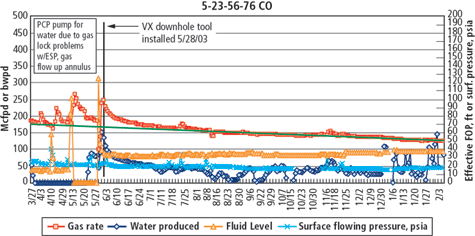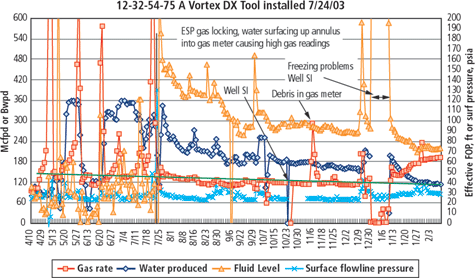|
| |
|

By Petroleum Technology Transfer Council |
Optimized flow device eliminates CBM lift equipment, reduces costs
In two examples, about 2.7 MMcf per year of deferred gas production was saved. Considering installed cost, the new equipment paid out in about seven months
Mike Olson, Marathon Oil Co., Houston; Tom Smith and Brad Fehn, Vortex Flow LLC, Englewood, Colorado
Marathon Oil Co. successfully deployed new tools to convert coalbed methane (CBM) wells that were being mechanically dewatered to flowing gas producers. By eliminating downhole pumping equipment, variable and fixed LOE costs decreased dramatically – from an average $875 per month to $15 per month. Considering installed cost, the tools paid out in about seven months. Prior artificial lift equipment could be deployed in other CBM wells or sold for salvage. Some lost production was avoided with continuous, stabilized flow and elimination of water-entrained gas volumes that were ultimately vented. In two examples, since prior failures with associated downtime were eliminated, about 2.7 MMcf per year of deferred production was saved. This $10,000 cash-flow benefit alone essentially pays for tool installation.
CBM IN POWDER RIVER BASIN
Most of the coal formations in the Powder River basin contain significant water. These coals often need to be dewatered before gas production can occur. Traditionally, these wells have been completed openhole through the coal seam, with a downhole pump that pumps water up the tubing, enabling gas flow up the casing annulus. These water pumping methods – generally either progressive cavity pumps (PCPs) or electric submersible pumps (ESPs) – have some drawbacks that lead to significant ongoing Lease Operating Expenses (LOEs). This project confirmed that, when applied under the right conditions, the Vortex DX tools enhance fluid-flow efficiency enough to convert the wells from pumping wells into producers, where both gas and water are produced through the tubing with the casing shut-in.
TECHNOLOGY DESCRIPTION
The new technology employs patented, proprietary Ecoveyor technology for oil and gas industry applications. It combines specific tool geometry and precise machining, and applies the laws of fluid dynamics to develop tools that optimize the flow within a pipe. The tools convert turbulent flow into helical flow with a slow-moving boundary layer closest to the pipe wall. This flow pattern reduces frictional pressure drop and moves liquids more efficiently. Tools have been developed and deployed for both surface and downhole applications. The downhole tool creates an optimally efficient multiphase flow regime that reduces the gas volume needed to lift water. This results in more water per Mcf being lifted, as compared to multiphase fluids flowing up tubing without the downhole tool.
These downhole tools are being fitted to 1.5, 1.9, 2-3/8 and 2-7/8 -in. tubing inside of casing sizes from 4-in. OD and up. The standard tools are made of 304L stainless steel. Installation is easy; the tools simply thread on the bottom of the tubing. There are no moving parts, so tool life, yet to be determined in field tests, should not be an issue.
The downhole tools lower flowing bottomhole pressures in gas wells by reducing liquid holdup in the tubing. In many applications, they reduce the slugging that is common when lifting large volumes of water with minimal gas.
FIELD EXPERIENCE
In the cases discussed here, these tools were able to initiate flow without swabbing the well in or venting to atmosphere. In each case, after the tool was installed, the well was shut in overnight and allowed to build pressure. Opening the tubing to a low-pressure surface separator initiated flow. The surface two-phase separators are operated at 5 – 20 psig, with a small electric pump used to evacuate the water to a separate water line. The dry gas is metered at the wellhead in these cases and routed to the gathering POD in a separate gas line. Using surface separators helps alleviate problems with metering wet gas as well as liquid dropout in the gas-gathering line, which could ultimately result in additional backpressure on the coal.
Starting in May 2003, Marathon Oil installed six downhole tools. These installations were targeted to replace PCPs and ESPs in mature CBM wells. The wells were shallow, with coal depths ranging from 500 to 900 ft. Gas production varied between 80 and 180 Mcfd, with associated water rates between 70 and 266 bpd. In three wells, gas and water production has been steady since the tools were installed nearly a year ago. The other three installations were only temporary and, due to unrelated operational problems, the tools were pulled.
The additional casing pressure (effective FOP on graphs) resulting from the well being produced in this manner does not appear to have decreased well productivity, which may be explained by the elimination of a constantly rising and falling fluid level in the casing/ tubing annulus. This erratic fluid level can be caused by the on/off status of the downhole water pump, and it can also be a function of water being lifted partially upward by the annular gas flow, causing an abnormally high fluid-density gradient in the annular space. Data for two wells illustrate the tool's performance in Marathon's CBM fields near Gillette, Wyoming.
The 5-23-56-76 CO well (Fig. 1) was pumped with a PCP pump immediately before installing the new tool. The well had previously been pumped using an ESP, which was constantly gas locking and failing. The PCP pump also experienced the same gas-locking issues and caused severe pump and tubing wear to the point of failure. LOE costs, due largely to pumping equipment failures and electrical costs, averaged $675/mo. in the 12 months prior to May 2003. These lift-related costs have been nearly eliminated since the downhole tool was installed, with only $15/mo. in electrical costs now required to operate the small surface separator's water pump. Gas and water production have since stabilized and appear to be following normal decline.
 |
Fig. 1. Well 5-23-56-76 CO. Installation on 2-3/ 8-in. tubing at 580 ft, coal openhole 581 – 623 ft.
|
|
The 12-32-54-75A well (Fig. 2) was pumped with an ESP before installing the new downhole tool. Production rates were very erratic and suspect, due to water surfacing up the annulus and gas spinning the turbine water meter. The ESP pumps were hard to control using fluid level sensors because of constantly changing annular pressure as water attempted to surface up the annulus. LOE costs due to pumping equipment averaged $1,075/mo. in the 12 months prior to July 2003. These lift-related costs have been reduced to $15/mo. since the downhole tool replaced the ESP system. Again, gas and water production have stabilized and appear to be following normal decline.
 |
Fig. 2. Well 12-32-54-75A. Installation on 1.9-in. tubing at 521 ft, coal openhole 530 – 562 ft.
|
|
ECONOMIC CONSIDERATIONS
In the above examples, the combined tool and well service cost per installation is about $6,000. Considering only these costs, the installations paid out in about seven months. Previously used artificial lift equipment was redeployed in other wells or salvaged. Some lost production was avoided with stable operations and the elimination of incidental gas loss to the water collection system. The elimination of deferred gas volumes resulting from downtime for equipment failures in these two examples is estimated at 2.7 MMcf per year, which adds about $10,000 per year in cash flow, essentially paying for the cost of the downhole tool installations. 
ACKNOWLEDGEMENT
Reported testing received funding support from DOE's Stripper Well Consortium. For further information, go to: http://www.energy.psu.edu/swc/ or contact Joel Morrisson, Penn State University, at: jlm9@psu.edu or 814-865-4802.
THE AUTHORS
|
 |
Mike Olson is currently a program manager in strategic sourcing at Marathon Oil Co. Prior to his current position, he worked 16 years for Marathon in various production and construction engineering assignments onshore and offshore Alaska, Wyoming and Texas. He earned a BS degree in petroleum engineering from Montana Tech. E-mail: mrolson@marathonoil.com
|
 |
Brad Fehn is the CEO of Vortex Flow LLC, based in Englewood, Colorado. He has an extensive background in bringing new technologies to the commercial market. Prior to Vortex, he was involved in the venture capital industry with iSherpa Capital in Englewood, Colorado, and has been a CFA since 2000.
|
 |
Tom Smith is currently the VP of engineering for Vortex Flow LLC, based in Englewood, Colorado. He previously spent 22 years with Marathon Oil Co. in various assignments in the Rockies and Texas. He earned a BS degree in petroleum engineering from Montana Tech and is a registered PE in Wyoming. E-mail: tsmith@vortexflowllc.com.
|
|







